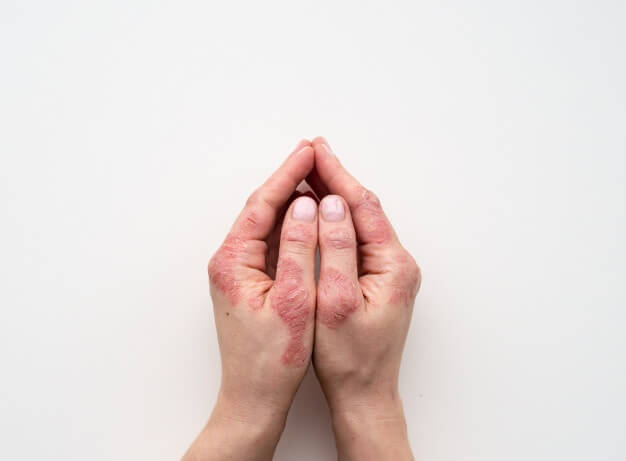Psoriasis is an autoimmune skin condition that causes skin cells to build up rapidly on the skin’s surface. A common sub-type of psoriasis is pustular psoriasis. Pustular psoriasis can be life-threatening when it is widespread.
Pustules are pus-filled bumps. They can appear under the skin, in the mouth, or inside the nail. The pus-filled bumps join together and burst open about 24 to 48 hours after they appear. Read on to learn more about pustular psoriasis.
What is Pustular Psoriasis?
Pustular Psoriasis is also known as Pustulosis. This skin condition is a rare form that mainly shows up on the palms of the hands and the soles of the feet. It affects about 3% of Psoriasis patients. It usually affects people between the ages of 15 to 35 years old.
It can also affect younger children, but it is uncommon for children under 10 years old to have it. Pustular Psoriasis is painful and can be destructive.
What are the Types of Pustular Psoriasis?
Palmoplantar Pustulosis (PPP)
Palmoplantar Pustular Psoriasis is characterized by blisters on the palms and soles of the feet. The pus-filled patches can brown, peel off, or crust over. Cracks can also appear on your skin. Smokers are most likely to get PPP. Psoriasis of this kind may appear and disappear.
Von Zumbusch Pustular Psoriasis
General pustular psoriasis (GPP) or von Zumbusch [vahn zuhm-BOOSH] psoriasis presents widespread symptoms. This type appears suddenly and rapidly and is often associated with a fever, chills, severe itching, alterations in heart rate, exhaustion, and weakness. Psoriasis of the gingival plaque type is the most serious, potentially fatal form.
Acropustulosis
Small, very painful lesions pop up on your fingertips or toes. The pain can make it hard to use your fingers or toes. It can sometimes cause harm to nails or even to bones.
How is Pustular Psoriasis Diagnosed?
If you observe any blister, pus-filled patches, or a rash that does not get better in a few days, you need to consult your doctor, who will help you find a solution before it gets worse.
If you visit an Angletoner emergency room, our doctors may perform a comprehensive blood count to check for signs of elevated inflammation or abnormal white blood cells.
If you have pustular psoriasis, your blood work may indicate decreased lymphocytes, a white blood cell. When evaluating a pustule, our doctors might take a sample and examine it.
What Triggers Pustular Psoriasis?
Many factors may trigger Pustular Psoriasis. They include:
- Exposure to too much ultraviolet (UV) light
- Stress
- Injury
- Alcohol
- Pregnancy
- Certain drugs like Penicillin (antibiotic), Nonsteroidal anti-inflammatory drugs (ibuprofen, naproxen), Calcipotriol (a psoriasis drug), etc.
- Steroids
- Unidentifiable reasons
How Do You Treat Pustular Psoriasis?
Several treatment options exist for pustular psoriasis, including phototherapy, topicals, oral medications, and biologics. Depending on the severity of your symptoms and your medical history, you and your healthcare provider will decide on the best treatment plan.
How Can You Prevent Pustular Psoriasis?
It can be highly distressing physically and emotionally when you have pustular psoriasis. Because it has such a wide range of causes, you have little control over it. However, you can lower your risk by doing the following things:
- Quit smoking
- Manage your weight
- Avoid stress
- Avoid excessive sunlight
- Reduce your alcohol intake
Conclusion
It is common for pustular psoriasis to make you feel anxious, but treatment can help manage it. There are several ways to treat it, depending on the type, how often it flares, how you respond to treatment, and how healthy you are.


